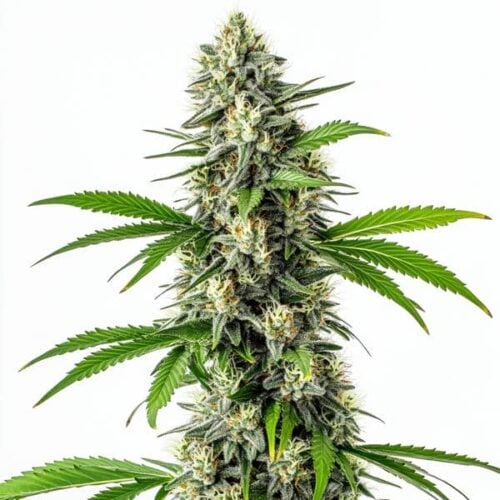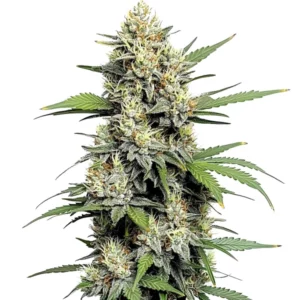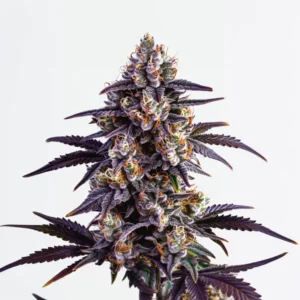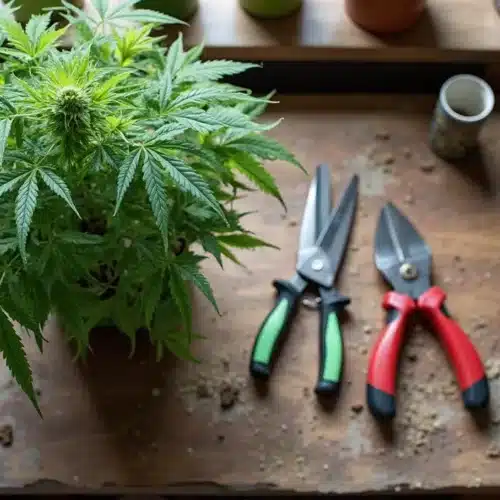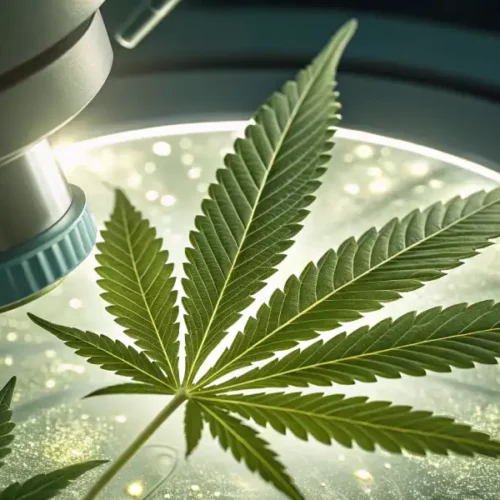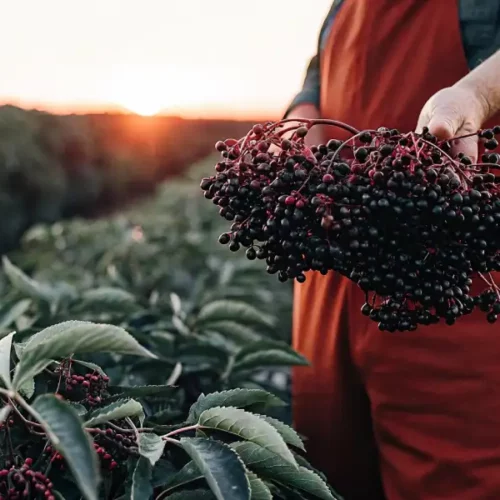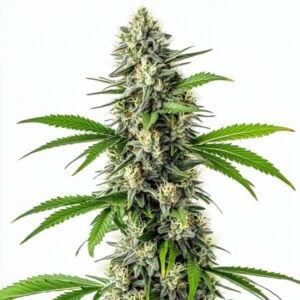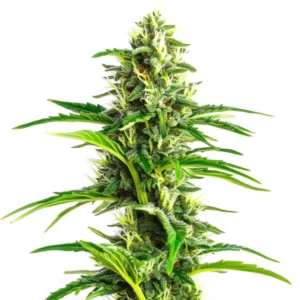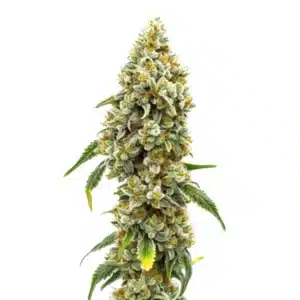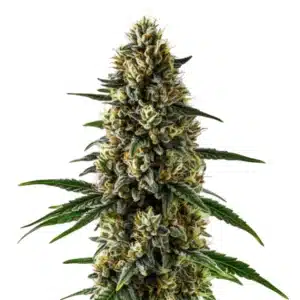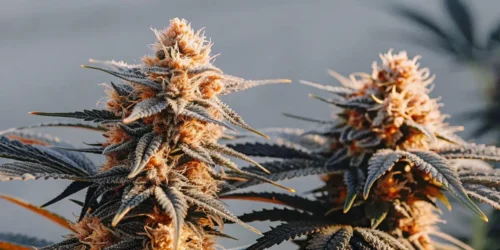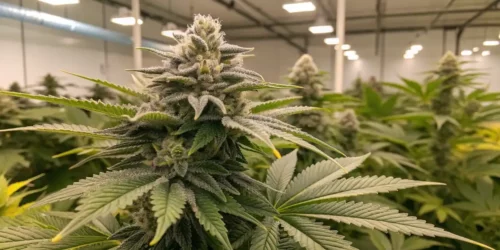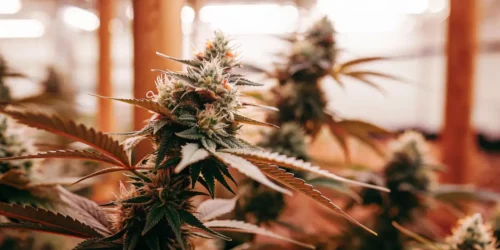Harle Tsu Strain Description
Harle Tsu Strain is a renowned high-CBD cannabis strain that has garnered popularity among medicinal users due to its therapeutic effects without intense psychoactive highs. A hybrid cross of Harlequin and Sour Tsunami, Harle Tsu typically contains a CBD-to-THC ratio of around 20:1, making it ideal for those seeking relief from ailments such as pain, anxiety, and inflammation without the potent “high” commonly associated with THC-dominant strains.
Recommended Strains
CBD Harle-Tsu
 THC: 1%
THC: 1% Type of seed: CBD
Type of seed: CBD Phenotype: Mostly Sativa
Phenotype: Mostly Sativa Day to flower: 8 - 9 weeks
Day to flower: 8 - 9 weeks
This strain typically produces dense, medium-sized buds that are bright green with orange pistils and covered in frosty trichomes. The aroma is a delightful combination of earthy, pine, and citrus notes, while the flavor profile is marked by sweet, woody, and herbal undertones. It is perfect for both recreational users who prefer mild effects and medicinal users who want the therapeutic benefits of cannabis without the psychoactive intensity.
Its unique terpene profile includes high levels of myrcene, caryophyllene, and pinene, which contribute to its calming, anti-inflammatory, and stress-relieving properties. With THC levels typically below 1%, it is one of the most popular strains for those seeking a pure CBD experience.
Promos & Deals
Environmental Requirements for Growing Harle Tsu
Providing the right growing environment is key to unlocking Harle Tsu’s full potential. Whether you are growing cannabis indoors or outdoors, it’s important to optimize conditions for the strain’s unique needs.
It thrives in a Mediterranean-like climate with daytime temperatures between 70-85°F (21-29°C). Indoors, it is best to maintain a consistent temperature and humidity level throughout the plant’s lifecycle to prevent issues such as mold and mildew, especially during the flowering phase.
For indoor growers, using a high-quality LED grow light is essential to replicate natural sunlight and support vigorous growth. During the vegetative stage, it benefits from a light schedule of 18 hours of light and 6 hours of darkness. Once it enters the flowering stage, switch to a 12/12 light cycle to initiate bud production.
Outdoors, Harle Tsu performs well in regions with long, warm summers. If you live in a cooler climate, consider using a greenhouse to protect your plants and extend the growing season. Outdoor plants should be positioned in a spot that receives ample sunlight throughout the day.
Humidity levels should be maintained between 40-50% during the vegetative stage and lowered to 30-40% during flowering to prevent moisture-related issues. Good air circulation is also crucial for preventing mold and keeping your plants healthy, so ensure your growing space has adequate ventilation.
Setting Up the Growing Cannabis Space
Setting up an optimal grow space for Harle Tsu is essential for a successful harvest. Whether growing indoors or outdoors, these considerations will help you achieve the best results:
Indoor Cannabis Cultivation
Indoor cultivation allows you to have full control over the environment, which can lead to higher yields and better-quality buds. When growing indoors, select a spacious grow tent or room to accommodate the size of your plants. Ensure your grow space has proper ventilation to regulate temperature and humidity levels.
LED grow lights or HPS lamps should be used to provide sufficient light, with reflectors or Mylar walls to maximize light distribution. During the vegetative stage, position the lights close to the canopy and gradually increase the distance as the plants grow taller. Proper light distribution is essential for healthy leaf development and bud production.
Choose a well-draining soil or soilless medium such as coco coir or a hydroponic system for growing this strain. The ideal pH level for soil should be between 6.0-6.5, while hydroponic setups should aim for a pH of 5.5-6.0 to maximize nutrient uptake.
Outdoor Cannabis Cultivation
When growing Harle Tsu outdoors, find a location with access to ample sunlight and well-draining soil. Amend the soil with organic compost or nutrients to ensure your plants have the necessary resources for vigorous growth. Outdoor plants benefit from natural sunlight but may need extra protection from strong winds or rain. Consider using windbreaks or staking the plants to prevent damage.
To increase bud size and promote healthier growth, use training techniques such as low-stress training (LST) or topping. These methods encourage the plant to grow horizontally, which allows for more light penetration and airflow to all parts of the plant.

Propagation and Germination of Harle Tsu
Successful germination is the first step to a healthy harvest. This seeds are typically available in feminized or regular forms, with feminized seeds being ideal for growers who want to ensure all their plants produce buds.
Start by soaking your seeds in distilled water for 24-48 hours to soften the outer shell. This will encourage the seeds to sprout more quickly. After soaking, transfer the seeds to a damp paper towel, place them in a dark, warm location, and check them daily. Once the taproots have emerged, gently place the seeds into a seedling tray or small pots filled with a light, well-draining soil mix.
Maintain a temperature of 70-80°F (21-27°C) and a humidity level of 60-70% for optimal germination. Provide gentle light using CFL bulbs or a low-intensity LED to avoid shocking the seedlings during their early growth stages. As the seedlings develop their first set of true leaves, they can be transplanted into larger pots or directly into the outdoor soil if you’re growing outdoors.
Vegetative Phase of Harle Tsu Strain
During the vegetative phase, Harle Tsu focuses on developing its root system, stems, and leaves, preparing itself for the flowering stage. Providing the right environmental conditions and nutrients during this stage is essential for producing strong and healthy plants.
Lighting: It requires 18-20 hours of light per day during the vegetative stage to maximize growth. High-quality LED or HID lights are recommended to provide the necessary light spectrum for vigorous growth. Be sure to position the lights close to the canopy, gradually increasing the distance as the plants grow taller.
Nutrition: During the vegetative stage, Harle Tsu requires a nutrient-rich diet that is high in nitrogen to support leafy growth. Use a balanced cannabis fertilizer with higher nitrogen content and follow the recommended feeding schedule to avoid nutrient deficiencies or excesses. Monitor the plants closely for signs of yellowing or nutrient burn and adjust feeding levels accordingly.
Watering: Water your plants regularly but avoid overwatering, as excess moisture can lead to root rot or fungal diseases. Allow the top inch of soil to dry out before watering again, and ensure your pots have good drainage to prevent waterlogging.
Flowering Phase
The flowering phase is when this strain begins to produce its characteristic buds. This stage requires careful attention to light, nutrition, and environmental conditions to maximize yield and cannabinoid content.
Lighting: During the flowering phase, switch to a 12/12 light cycle (12 hours of light and 12 hours of darkness) to trigger bud development. Ensure your grow lights provide sufficient intensity and coverage, and adjust the distance from the canopy to avoid light burn. For outdoor growers, the flowering phase typically begins in late summer as the days become shorter.
Nutrition: As Harle Tsu enters the flowering phase, switch to a bloom fertilizer with higher levels of phosphorus and potassium to support bud development and resin production. Monitor the plants closely and adjust nutrient levels as needed to prevent deficiencies.
Temperature and Humidity: During flowering, lower the humidity levels to 30-40% to reduce the risk of mold or bud rot. Maintain a temperature range of 65-75°F (18-24°C) for optimal resin production.
Cannabis Fertilization and Nutrition
Proper nutrition is key to maximizing the growth and yield of Harle Tsu. Throughout its lifecycle, it requires different nutrient formulations to support its growth, flowering, and resin production.
Choosing the Right Fertilizer: For the vegetative phase, choose a nutrient solution high in nitrogen to promote leafy growth. During the flowering phase, switch to a bloom fertilizer that is higher in phosphorus and potassium to support bud development. Organic nutrients or cannabis-specific fertilizers are ideal for maintaining the health and quality of your plants.
Supplements and Additives: Consider adding supplements such as calcium, magnesium, or silica to enhance the plant’s overall health and resistance to pests or diseases. Beneficial microbes or mycorrhizae can also be added to improve nutrient absorption and root health.
Be sure to follow the manufacturer’s instructions when “`html using nutrients and supplements to avoid nutrient lockout or overfeeding, which can stress your plants. Regularly check the pH of your water and soil to ensure it falls within the optimal range for nutrient uptake (6.0-6.5 for soil, 5.5-6.0 for hydroponics).
Pest And Disease Control for Cannabis Growing
Like any cannabis strain, it can be vulnerable to pests and diseases if not properly monitored. Taking proactive measures to prevent infestations and address issues early can save your harvest.
Prevention: A clean grow space is crucial to prevent pests such as spider mites, aphids, or thrips from damaging your plants. Regularly check for signs of pests on the underside of leaves and at the base of the plant. Maintain a sterile environment by removing any dead plant matter and debris from the grow space. Introducing beneficial insects like ladybugs or predatory mites can also naturally reduce pest populations.
Airflow: Ensuring proper air circulation in your grow space is key to reducing the risk of fungal diseases such as powdery mildew or bud rot. Indoor growers should use oscillating fans and ventilation systems to create a steady airflow around the plants. Outdoor growers should ensure that their plants are spaced far enough apart to allow adequate air movement between them.
Corrective Actions: If pests or diseases are detected, act quickly. Organic insecticides such as neem oil or insecticidal soaps can be used to treat infestations. For fungal issues like mold, affected parts of the plant should be removed immediately, and airflow should be increased to prevent further spread. Consider using organic fungicides or natural remedies such as a milk spray solution to treat powdery mildew.
Harvesting and Curing Harle Tsu
Harvesting your strain at the right time is critical to preserving its cannabinoid and terpene profile. Follow these guidelines to achieve the best results:
Trichome Maturity: The best way to determine when to harvest your plants is by checking the trichomes with a magnifying tool. Trichomes should appear milky or cloudy with some turning amber, which signals the peak cannabinoid content. Harvesting at this stage ensures you capture the strain’s medicinal benefits, especially its high CBD content.
Harvesting: Using clean, sterilized scissors, cut the branches one by one and handle the buds carefully to avoid damaging the delicate trichomes. Remove the large fan leaves but leave the sugar leaves intact as they contain valuable cannabinoids and terpenes.
Drying: Hang the harvested branches upside down in a dark, well-ventilated area with temperatures around 60-70°F (15-21°C) and humidity levels around 50-60%. This will prevent mold and allow the buds to dry slowly over 7-14 days, depending on the environment.
Curing: Once dried, carefully trim the buds and place them in airtight glass jars. Store the jars in a cool, dark place with a humidity level of around 58-62%. Open the jars daily during the first week to release excess moisture. Curing can take 2-4 weeks or longer, enhancing the flavor and effects of the final product.
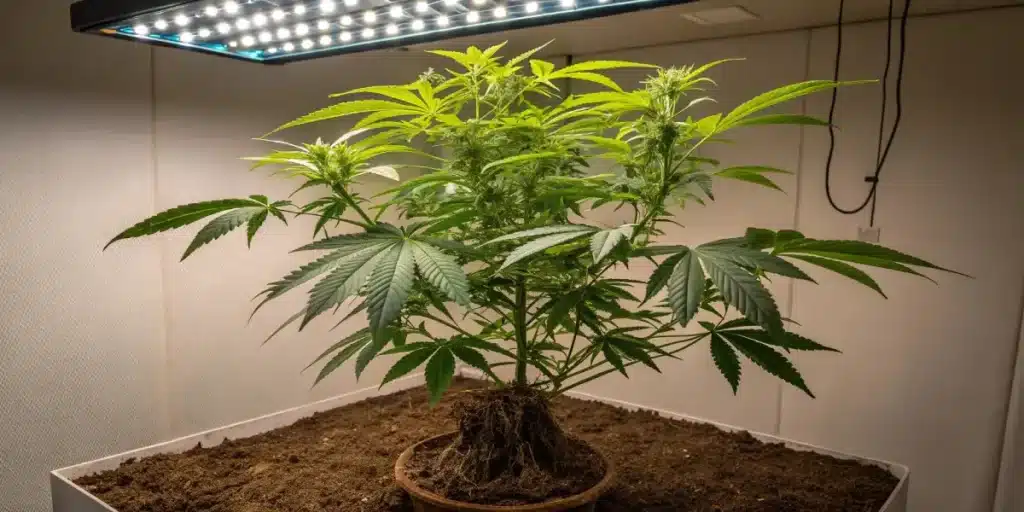
Is Harle Tsu Indica or Sativa?
It is a balanced hybrid strain, though it tends to lean slightly towards the Indica side in terms of growth and structure. This balanced profile means it offers the best of both worlds: the calming, body-relaxing effects of an Indica combined with the uplifting, cerebral clarity of a Sativa. With high CBD content and minimal THC, Harle Tsu is primarily used for its medicinal properties rather than psychoactive effects. This makes it a favorite among users looking for relief from pain, stress, and inflammation without feeling overly sedated or “high.”
Advantages of Growing Harle Tsu Strain
Growing Harle Tsu offers numerous advantages, particularly for medical growers:
- High CBD content with minimal THC, perfect for medicinal use without psychoactive effects.
- Resilient and relatively easy to grow for both indoor and outdoor cultivators.
- Adaptable to various growing environments, from temperate climates to controlled indoor setups.
- Unique aroma and flavor profile, making it a pleasant strain to cultivate and consume.
- High resistance to common pests and diseases.
- Ideal for beginners or medical cannabis patients seeking therapeutic benefits.
Disadvantages
- Yields may be lower compared to high-THC strains, especially for recreational growers looking for large harvests.
- Due to its high CBD content, it does not provide the intense psychoactive effects sought after by recreational users.
- Like most strains, Harle Tsu requires careful monitoring during the flowering phase to prevent mold and mildew in humid environments.
- Some growers may find it challenging to source quality feminized seeds.
Why Buy Harle Tsu Strain
It is an excellent choice for medicinal users and growers looking to cultivate a strain with high therapeutic potential. Its high CBD and low THC ratio makes it ideal for treating a variety of conditions, including chronic pain, anxiety, inflammation, and seizures. The strain’s minimal psychoactive effects also make it suitable for users who want relief without feeling “stoned.”
1. Medicinal Benefits: it has been known to help alleviate symptoms of various ailments without the mind-altering effects of high-THC strains.
2. Easy to Grow: This strain is relatively easy to grow and resilient to common pests, making it an excellent choice for both novice and experienced growers.
3. Pleasant Aroma and Taste: With its earthy, citrusy, and piney flavors, Harle Tsu provides a smooth and enjoyable smoking experience.
4. Versatile for Different Grow Setups: it can thrive in both indoor and outdoor environments, giving growers flexibility in how they cultivate it.
Problems in Cultivating Harle Tsu
While it is generally a hardy strain, growers may encounter a few common issues:
1. Mold and Mildew: The dense bud structure of Harle Tsu can make it susceptible to mold and mildew if humidity levels are not carefully controlled during the flowering phase. Maintain proper airflow and keep humidity levels low to prevent issues.
2. Nutrient Sensitivity: Although relatively resilient, this strain may be sensitive to nutrient overfeeding, particularly during the flowering phase. It’s important to monitor nutrient levels closely to avoid nutrient burn.
3. Moderate Yields: While the quality of the buds is high, the overall yield of Harle Tsu may be lower compared to other strains, particularly if growing in less-than-optimal conditions.
Similar Strains to Harle Tsu
- ACDC: Another high-CBD strain, ACDC is known for its therapeutic effects with minimal psychoactive properties, making it a great alternative to Harle Tsu.
- Charlotte’s Web: A widely recognized high-CBD strain, Charlotte’s Web is ideal for those seeking the medicinal benefits of cannabis without the high THC levels.
- Cannatonic: Known for its balanced CBD to THC ratio, Cannatonic offers therapeutic benefits with minimal psychoactive effects, making it a great choice for those looking to manage pain, anxiety, and inflammation effectively.
Tips for Professional Growers
For experienced growers looking to optimize their yields and potency, consider the following tips:
- Implement advanced training techniques such as Screen of Green (SCROG) or Sea of Green (SOG) to maximize light exposure and bud production.
- Use organic nutrients and supplements to enhance flavor, cannabinoid content, and terpene profiles.
- Monitor and control the pH levels of your growing medium to ensure optimal nutrient uptake throughout the plant’s lifecycle.
- Maintain consistent humidity levels during flowering to prevent the development of mold or bud rot, especially when growing indoors.
- Ensure a thorough curing process to enhance the flavor and cannabinoid content of the final product.
FAQs
How long does it take to grow Harle Tsu?
Harle Tsu typically takes around 8-10 weeks to flower indoors. Outdoor growers can expect to harvest in mid to late October, depending on the climate.
What is the THC to CBD ratio of Harle Tsu?
It is known for its high CBD content, with a typical CBD to THC ratio of 20:1. THC levels are often below 1%, making it ideal for medicinal use without psychoactive effects.
Can beginners grow Harle Tsu?
Yes, it is a great strain for beginners. It is relatively easy to grow, resilient to common pests and diseases, and adapts well to both indoor and outdoor growing conditions.
What are the primary terpenes in Harle Tsu?
The dominant terpenes in Harle Tsu are myrcene, caryophyllene, and pinene. These contribute to its earthy, citrus, and pine flavor profile, as well as its calming and anti-inflammatory effects.
Is Harle Tsu suitable for medicinal use?
Yes, it is primarily used for medicinal purposes due to its high CBD content and low THC levels. It is effective in relieving pain, inflammation, anxiety, and other medical conditions without causing a strong psychoactive high.
What is the yield of Harle Tsu?
When grown indoors, this yields approximately 400-500 grams per square meter. Outdoor plants can yield up to 500 grams per plant, depending on the growing conditions.

